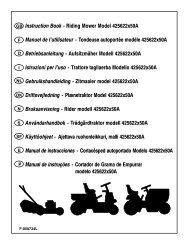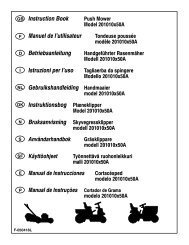Instruction Book − Riding Mower Model ... - Safe Motor AS
Instruction Book − Riding Mower Model ... - Safe Motor AS
Instruction Book − Riding Mower Model ... - Safe Motor AS
Create successful ePaper yourself
Turn your PDF publications into a flip-book with our unique Google optimized e-Paper software.
2. Raise the lift lever to the highest position.<br />
3. Move the throttle control to a position between<br />
SLOW and F<strong>AS</strong>T.<br />
4. Slowly push the speed control pedal forward<br />
to the desired speed.<br />
How To Operate With The <strong>Mower</strong><br />
Housing<br />
IMPORTANT: When you operate with the<br />
mower housing, always operate with the<br />
throttle control in the F<strong>AS</strong>T position.<br />
1. Start the engine.<br />
2. Move the lift lever to a height of cut position.<br />
In high or thick grass, cut the grass in the<br />
highest position first and then lower the<br />
mower housing to a lower position.<br />
3. Move the throttle control to the SLOW position.<br />
4. Slowly move the blade rotation control to the<br />
ENGAGE position.<br />
5. Move the throttle control to the F<strong>AS</strong>T position.<br />
6. Slowly push the speed control pedal to the<br />
desired speed.<br />
NOTE: When you mow in heavy grass or<br />
mow with a bagger, use a slow forward<br />
speed.<br />
7. Make sure the level of cut is still correct.<br />
After you mow a short distance, look at the<br />
area that was cut. If the mower housing does<br />
not cut level, see the instructions on “How To<br />
Level The <strong>Mower</strong> Housing” in the Maintenance<br />
section.<br />
WARNING: For better control of the<br />
unit, select a safe speed.<br />
How To Operate On Hills<br />
WARNING: Do not ride up or down<br />
slopes that are too steep to back<br />
straight up. Never ride the unit<br />
across a slope.<br />
WARNING: To help prevent tipping<br />
over or loss of control, be very cautious<br />
on slopes and avoid sharp,<br />
sudden turns.<br />
1. Control the speed only with the speed control<br />
pedal. Do not use the brake pedal on a hill.<br />
2. To help prevent an accident, slowly move the<br />
speed control pedal. Avoid sudden turns or<br />
changes in speed.<br />
3. To reduce forward speed when going down a<br />
hill, slowly release the speed control pedal<br />
until the unit slows to the desired speed.<br />
How To Stop On a Hill<br />
1. Avoid stopping on a hill. If you must quickly<br />
stop in an emergency, remove your right foot<br />
from the speed control pedal and quickly depress<br />
the left brake pedal.<br />
2. Set the parking brake.<br />
3. Before you dismount from the seat, move the<br />
throttle control to the SLOW position, move<br />
the blade rotation control to the DISEN-<br />
GAGED position, turn off the engine and set<br />
the parking brake.<br />
F-050725L<br />
How To Start Operation On A Hill<br />
1. Start the engine<br />
2. Move the blade rotation control to the EN-<br />
GAGED position.<br />
3. Move the throttle control to the F<strong>AS</strong>T position.<br />
4. Depress the brake pedal and release the<br />
parking brake. As you release the parking<br />
brake, push the speed control pedal to the<br />
desired speed.<br />
Slowly push the speed control<br />
pedal as you release the parking<br />
brake. The parking brake must be<br />
disengaged before the speed control pedal<br />
is able to engage the transmission.<br />
All-Wheel Steering<br />
Because both front and rears wheels turn, the<br />
tractor is very maneuverable. Because of the<br />
shorter turning radius, the tractor can operate<br />
closely around objects, such as shrubs and<br />
trees. However, because the rear wheels turn<br />
toward the object, the wheels could become<br />
wedged against a wall, tree, fence or other object.<br />
To free the wheels, do the following:<br />
1. Disengage the blades.<br />
2. Slightly turn the steering wheel away from<br />
the object. Do not sharply turn (more than 7<br />
degrees) the steering wheel or the rear<br />
wheels will turn into the object.<br />
3. Slowly back away from the object.<br />
WARNING: Before backing up, always<br />
check behind for children,<br />
pets or other objects.<br />
Before Starting The Engine<br />
Check the oil<br />
NOTE: The engine was shipped from the factory<br />
filled with oil. Check the level of the oil.<br />
Add oil as needed. See the engine manufacturer’s<br />
instructions for the type of petrol and<br />
oil to use.<br />
1. Make sure the unit is level.<br />
NOTE: Do not check the level of the oil<br />
while the engine runs.<br />
2. Check the oil. Follow the procedure in the<br />
engine manufacturer’s instructions.<br />
3. If necessary, add oil until the oil reaches the<br />
FULL mark on the dipstick. The quantity of oil<br />
needed from ADD to FULL is shown on the<br />
dipstick. Do not add too much oil.<br />
Add Petrol<br />
WARNING: Always use a safety<br />
petrol container. Do not smoke<br />
when adding petrol to the fuel tank.<br />
Do not add petrol when you are inside an<br />
enclosure. Before you add petrol, stop the<br />
engine and let the engine cool for several<br />
minutes.<br />
(Figure 6) Fill the fuel tank (1) to the FULL (2)<br />
position with regular unleaded petrol. Do not use<br />
premium unleaded petrol. Make sure the petrol<br />
is fresh and clean. Leaded petrol will increase<br />
deposits and shorten the life of the valves.<br />
13<br />
How To Start The Engine<br />
GB<br />
WARNING: The electrical system<br />
has an operator presence system<br />
that includes a sensor switch for<br />
the seat. These components tell the<br />
electrical system if the operator is sitting<br />
on the seat. This system will stop the<br />
engine when the operator leaves the seat.<br />
For your protection, always make sure this<br />
system operates correctly.<br />
NOTE: The engine will not start unless you<br />
depress the clutch/brake pedal and move the<br />
blade rotation control to the DISENGAGE<br />
position.<br />
1. Push the brake pedal completely forward.<br />
Keep your foot on the pedal.<br />
2. Make sure the blade rotation control is in the<br />
DISENGAGE position.<br />
3. Move the throttle control completely forward<br />
to the CHOKE or F<strong>AS</strong>T position. Some models<br />
have a separate choke knob. Pull the<br />
choke knob to the full CHOKE position.<br />
4. Turn the ignition key to the START position.<br />
NOTE: If the engine does not start after<br />
four or five tries, move the throttle control<br />
to the F<strong>AS</strong>T position. Again try to start the<br />
engine. If the engine will not start, see the<br />
TROUBLE SHOOTING CHART.<br />
5. Slowly move the throttle control to the SLOW<br />
position.<br />
6. To start a hot engine, move the throttle control<br />
to a position between F<strong>AS</strong>T and SLOW.<br />
Mowing And Bagging Tips<br />
1. For a lawn to look better, check the cutting<br />
level of the mower housing. See “How To<br />
Level The <strong>Mower</strong> Housing” in the Maintenance<br />
section.<br />
2. For the mower housing to cut level, make<br />
sure the tyres have the correct amount of air<br />
pressure.<br />
3. Every time you use the unit, check the blade.<br />
If the blade is bent or damaged, immediately<br />
replace the blade. Also, make sure the nut<br />
for the blade is tight.<br />
4. Keep the blade(s) sharpened. Worn blades<br />
will cause the ends of the grass to turn<br />
brown.<br />
5. Do not cut or bag grass that is wet. Wet<br />
grass will not discharge correctly. Let the<br />
grass dry before cutting.<br />
6. Use the left side of the mower housing to trim<br />
near an object.<br />
7. Discharge the cut grass onto the mowed<br />
area. The result is a more even discharge of<br />
cut grass.<br />
8. When you mow large areas, start by turning<br />
to the right so that the cut grass will discharge<br />
away from shrubs, fences, driveways,<br />
etc. After one or two rounds, mow in the opposite<br />
direction making left turns until finished.<br />
9. If the grass is very high, cut two times to decrease<br />
the load on the engine. First cut with<br />
the mower housing in the highest position<br />
and then lower the mower housing for the<br />
second cut.<br />
10.For better engine performance and an even<br />
discharge of the cut grass, always operate<br />
the engine with the throttle in F<strong>AS</strong>T position.





